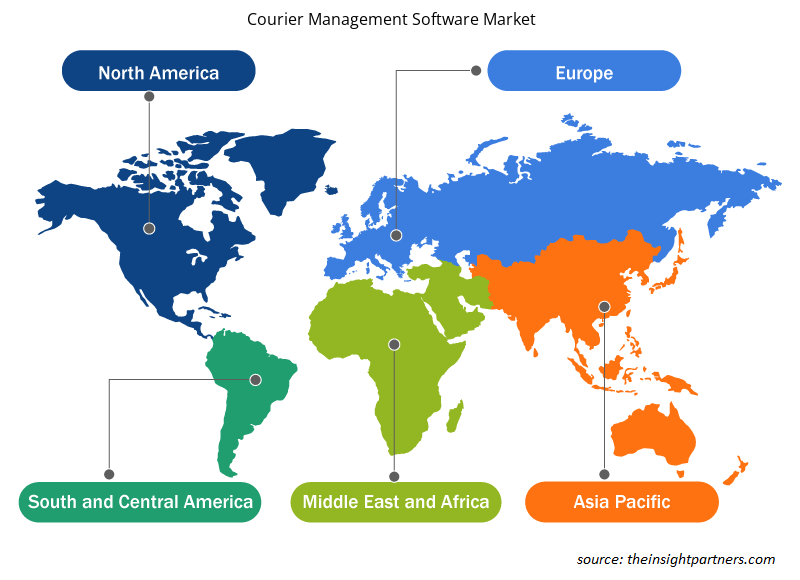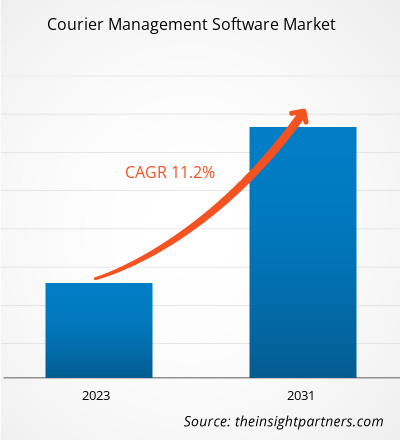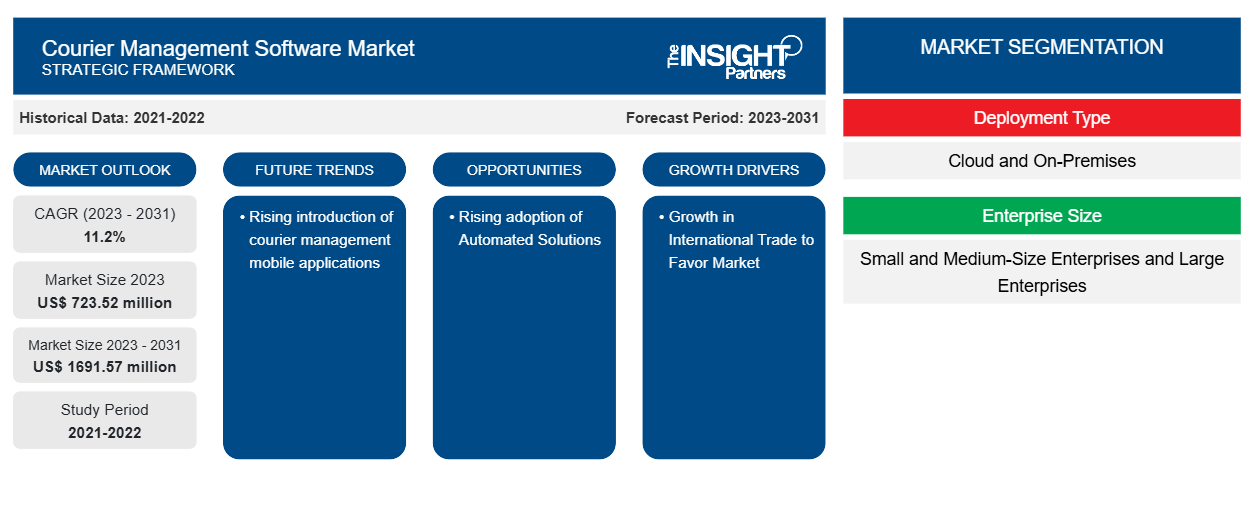من المتوقع أن ينمو حجم سوق برامج إدارة البريد السريع العالمية من 723.52 مليون دولار أمريكي في عام 2023 إلى 1691.57 مليون دولار أمريكي بحلول عام 2031؛ ومن المتوقع أن يتوسع بمعدل نمو سنوي مركب قدره 11.2٪ من عام 2023 إلى عام 2031. ومن المرجح أن يظل التقديم المتزايد لتطبيقات إدارة البريد السريع عبر الهاتف المحمول أحد الاتجاهات الرئيسية في سوق برامج إدارة البريد السريع.
تحليل سوق برامج إدارة البريد السريع
من المتوقع أن يؤثر نمو التجارة الدولية بشكل إيجابي على سوق برامج إدارة البريد السريع. ومع زيادة التجارة الدولية، ينمو أيضًا الطلب على حلول لوجستية فعّالة وإدارة التوصيل.
نظرة عامة على سوق برامج إدارة البريد السريع
برنامج إدارة البريد السريع هو حل برمجي شامل مصمم لمساعدة الشركات في إدارة وتتبع أوامر الشحن للطرود أو المنتجات بكفاءة. يوفر هذا البرنامج مجموعة من الميزات والوظائف التي تعمل على تبسيط جوانب مختلفة من عملية التسليم، مما يؤدي في النهاية إلى تحسين رضا العملاء وتحسين الكفاءة التشغيلية. يوفر برنامج البريد السريع مراقبة GPS في الوقت الفعلي للشحنات، مما يسمح للشركات بتتبع حالة وموقع الطرود طوال عملية التسليم.
قم بتخصيص هذا التقرير ليناسب متطلباتك
ستحصل على تخصيص لأي تقرير - مجانًا - بما في ذلك أجزاء من هذا التقرير، أو تحليل على مستوى الدولة، وحزمة بيانات Excel، بالإضافة إلى الاستفادة من العروض والخصومات الرائعة للشركات الناشئة والجامعات
- احصل على أهم اتجاهات السوق الرئيسية لهذا التقرير.ستتضمن هذه العينة المجانية تحليلاً للبيانات، بدءًا من اتجاهات السوق وحتى التقديرات والتوقعات.
محركات وفرص سوق برامج إدارة البريد السريع
نمو التجارة الدولية لصالح السوق
يؤثر النمو في التجارة الدولية بشكل إيجابي على سوق برامج إدارة البريد السريع. ومع زيادة التجارة الدولية، ينمو أيضًا الطلب على حلول فعّالة لإدارة الخدمات اللوجستية والتسليم. تنطوي التجارة الدولية على تبادل السلع والخدمات بين البلدان. وتتطلب تنسيقًا وإدارة فعّالة للخدمات اللوجستية، بما في ذلك النقل والتخزين والتسليم. تلعب برامج إدارة البريد السريع دورًا حاسمًا في تبسيط هذه العمليات وتحسين الكفاءة وضمان تسليم البضائع في الوقت المناسب.
تزايد استخدام الحلول الآلية
إن الاستثمارات المتزايدة في برامج التوصيل من قبل شركات التجارة الإلكترونية والشعبية المتزايدة للبرمجيات كخدمة (SaaS) تدفع سوق برامج التوصيل إلى الأمام. تلعب أنظمة البرامج هذه دورًا حيويًا في تبسيط العمليات التجارية، وتحسين التواصل مع العملاء، وتوفير رؤية فورية للشحنات، وتحسين خيارات التوجيه، والمزيد. من خلال دمج برامج التوصيل في أنظمتها الحالية، يمكن للشركات أتمتة عمليات مختلفة مثل إدخال طلبات العملاء، والحسابات المستحقة، وتتبع التسليم في الوقت الفعلي، وإدارة الحسابات. علاوة على ذلك، للحفاظ على القدرة التنافسية، ينفذ بائعو برامج التوصيل استراتيجيات تسعير متقدمة تقنيًا وتركز على العملاء.customer-centric pricing strategies.
تقرير تحليلي لتجزئة سوق برامج إدارة البريد السريع
إن القطاعات الرئيسية التي ساهمت في اشتقاق تحليل سوق برامج إدارة البريد السريع هي نوع النشر وحجم المؤسسة.
- بناءً على نوع النشر، ينقسم السوق إلى السحابة والمحلية. احتل قطاع السحابة حصة سوقية أكبر في عام 2023.
- بناءً على حجم المؤسسة، ينقسم السوق إلى شركات صغيرة ومتوسطة الحجم وشركات كبيرة. احتلت شريحة الشركات الكبيرة حصة سوقية أكبر في عام 2023.
تحليل حصة سوق برامج إدارة البريد السريع حسب المنطقة الجغرافية
ينقسم النطاق الجغرافي لتقرير سوق برامج إدارة البريد السريع بشكل أساسي إلى خمس مناطق: أمريكا الشمالية، وآسيا والمحيط الهادئ، وأوروبا، والشرق الأوسط وأفريقيا، وأمريكا الجنوبية/أمريكا الجنوبية والوسطى. سيطرت أمريكا الشمالية على سوق برامج إدارة البريد السريع في عام 2023. ونظرًا للشعبية المتزايدة لبرامج البريد السريع في تعزيز إدارة سلسلة التوريد ، فهناك طلب متزايد على منصة موثوقة يمكنها التعامل مع متطلبات الشحن الشاملة للتسوق عبر الإنترنت لكل من المنتجات الأساسية وغير الأساسية. يشهد القطاع التجاري في المنطقة تقدمًا تقنيًا كبيرًا، مما يغذي نمو سوق برامج البريد السريع. علاوة على ذلك، يساهم التبني السريع للتكنولوجيا في القطاع الصناعي في جميع أنحاء دول أمريكا الشمالية أيضًا في توسيع سوق برامج البريد السريع في المنطقة.
رؤى إقليمية حول سوق برامج إدارة البريد السريع
لقد قام المحللون في Insight Partners بشرح الاتجاهات والعوامل الإقليمية المؤثرة على سوق برامج إدارة البريد السريع طوال فترة التوقعات بشكل شامل. يناقش هذا القسم أيضًا قطاعات سوق برامج إدارة البريد السريع والجغرافيا في جميع أنحاء أمريكا الشمالية وأوروبا ومنطقة آسيا والمحيط الهادئ والشرق الأوسط وأفريقيا وأمريكا الجنوبية والوسطى.

- احصل على البيانات الإقليمية المحددة لسوق برامج إدارة البريد السريع
نطاق تقرير سوق برامج إدارة البريد السريع
| سمة التقرير | تفاصيل |
|---|---|
| حجم السوق في عام 2023 | 723.52 مليون دولار أمريكي |
| حجم السوق بحلول عام 2031 | 1691.57 مليون دولار أمريكي |
| معدل النمو السنوي المركب العالمي (2023 - 2031) | 11.2% |
| البيانات التاريخية | 2021-2022 |
| فترة التنبؤ | 2023-2031 |
| القطاعات المغطاة | حسب نوع النشر
|
| المناطق والدول المغطاة | أمريكا الشمالية
|
| قادة السوق وملفات تعريف الشركات الرئيسية |
|
كثافة اللاعبين في السوق: فهم تأثيرها على ديناميكيات الأعمال
يشهد سوق برامج إدارة البريد السريع نموًا سريعًا، مدفوعًا بالطلب المتزايد من المستخدم النهائي بسبب عوامل مثل تفضيلات المستهلكين المتطورة والتقدم التكنولوجي والوعي المتزايد بفوائد المنتج. ومع ارتفاع الطلب، تعمل الشركات على توسيع عروضها والابتكار لتلبية احتياجات المستهلكين والاستفادة من الاتجاهات الناشئة، مما يؤدي إلى زيادة نمو السوق.
تشير كثافة اللاعبين في السوق إلى توزيع الشركات أو المؤسسات العاملة في سوق أو صناعة معينة. وهي تشير إلى عدد المنافسين (اللاعبين في السوق) الموجودين في مساحة سوق معينة نسبة إلى حجمها أو قيمتها السوقية الإجمالية.
الشركات الرئيسية العاملة في سوق برامج إدارة البريد السريع هي:
- شركة كورير سوفت وير المحدودة
- مدير البريد السريع
- دلهيفيري
- شركة داتاتراك
- بوليصة الشحن الرقمية
- أنظمة البرمجيات الرئيسية
إخلاء المسؤولية : الشركات المذكورة أعلاه ليست مرتبة بأي ترتيب معين.

- احصل على نظرة عامة على أهم اللاعبين الرئيسيين في سوق برامج إدارة البريد السريع
أخبار سوق برامج إدارة البريد السريع والتطورات الأخيرة
يتم تقييم سوق برامج إدارة البريد السريع من خلال جمع البيانات النوعية والكمية بعد البحث الأولي والثانوي، والتي تتضمن منشورات الشركات المهمة وبيانات الجمعيات وقواعد البيانات. فيما يلي قائمة بالتطورات في السوق:
- في سبتمبر 2023، أطلقت شركة Delhivery، وهي شركة تقدم خدمات لوجستية، مؤخرًا حلًا لذكاء الموقع يسمى "LocateOne" لمساعدة الشركات على تحسين بيانات العناوين ودقة البيانات على الأسطح والحد من الاحتيال. تعد هذه الميزة الجديدة جزءًا من عروض برامج Delhivery على منصة OS1. OS1 عبارة عن منصة برمجية توفر حلولاً كاملة للشركات لإدارة عملياتها اللوجستية وسلسلة التوريد بكفاءة.
(المصدر: Delhivery، بيان صحفي، 2023)
تقرير سوق برامج إدارة البريد السريع والتغطية والنتائج النهائية
يوفر تقرير "حجم سوق برامج إدارة البريد السريع والتوقعات (2021-2031)" تحليلاً مفصلاً للسوق يغطي المجالات التالية:
- حجم السوق والتوقعات على المستويات العالمية والإقليمية والوطنية لجميع قطاعات السوق الرئيسية التي يغطيها النطاق
- ديناميكيات السوق مثل المحركات والقيود والفرص الرئيسية
- الاتجاهات المستقبلية الرئيسية
- تحليل مفصل لقوى PEST/Porter الخمس وSWOT
- تحليل السوق العالمي والإقليمي الذي يغطي اتجاهات السوق الرئيسية واللاعبين الرئيسيين واللوائح والتطورات الأخيرة في السوق
- تحليل المشهد الصناعي والمنافسة الذي يغطي تركيز السوق، وتحليل خريطة الحرارة، واللاعبين البارزين، والتطورات الأخيرة
- ملفات تعريف الشركة التفصيلية
- التحليل التاريخي (سنتان)، سنة الأساس، التوقعات (7 سنوات) مع معدل النمو السنوي المركب
- تحليل PEST و SWOT
- حجم السوق والقيمة / الحجم - عالمي، إقليمي، بلد
- الصناعة والمنافسة
- مجموعة بيانات إكسل
التقارير الحديثة
تقارير ذات صلة
شهادات العملاء
سبب الشراء
- اتخاذ قرارات مدروسة
- فهم ديناميكيات السوق
- تحليل المنافسة
- رؤى العملاء
- توقعات السوق
- تخفيف المخاطر
- التخطيط الاستراتيجي
- مبررات الاستثمار
- تحديد الأسواق الناشئة
- تحسين استراتيجيات التسويق
- تعزيز الكفاءة التشغيلية
- مواكبة التوجهات التنظيمية





















 احصل على عينة مجانية ل - سوق برامج إدارة البريد السريع
احصل على عينة مجانية ل - سوق برامج إدارة البريد السريع